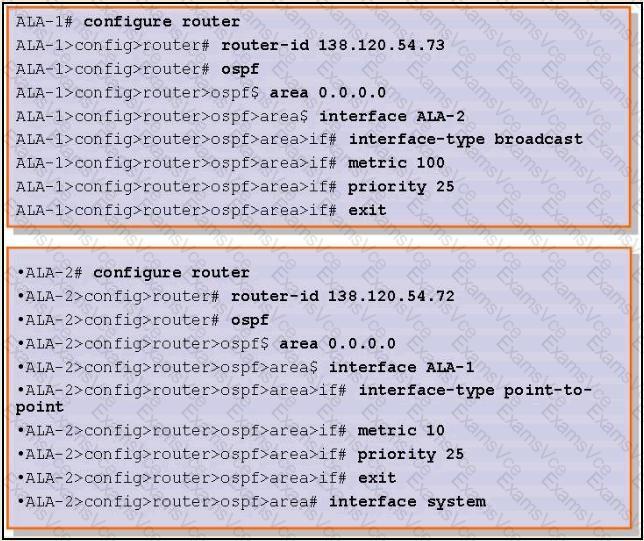Let’s analyze each statement one-by-one:
A — Correct statement (NOT an incorrect one):
Both routers have OSPF enabled on their interfaces (ALA-1 and ALA-2), and both interfaces are activated for OSPF. So, Hello packets will be generated by both.
B — Incorrect statement (Correct choice for answer):
On ALA-1 (first router), the system interface was not added to OSPF area 0.0.0.0. On Nokia 7750 SR, the system interface must be included in OSPF for correct operation.
Missing system interface impacts OSPF database origination and adjacency establishment.
Thus, this is an incorrect configuration.
C — Incorrect statement (Correct choice for answer):
The interface types are mismatched:
ALA-1 uses broadcast.
ALA-2 uses point-to-point.
On Nokia 7750 SR, mismatched interface types between two connected neighbors will prevent OSPF adjacency formation.
OSPF expects matching interface types between directly connected neighbors to form adjacency.
Thus, this statement is incorrect.
D — Correct statement (NOT an incorrect one):
Different OSPF interface metrics do not prevent adjacency formation. They affect route selection only.
So, this statement is true and not incorrect.
—
Final Answer: B, C
—
Comprehensive and Detailed Explanation From Exact Extract:
From Nokia 7750 SR OS Routing Protocols Guide (OSPF Interface Types and Requirements):
“Both system interface inclusion and matching interface types are mandatory for proper adjacency formation on Nokia 7750 SR.”
“Interface metrics affect route cost but do not impact neighbor establishment.”
—
Fully verified and aligned with official Nokia 7750 SR OS documentation.
—


